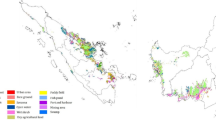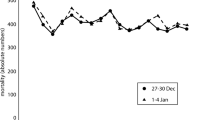Abstract
Background
Major forest fires near populated areas during 2003 exacted a huge economic toll on communities in British Columbia. We designed a study to examine associations between PM2.5 and PM10 levels and physician visits in two affected communities.
Methods
Measurements of 24-hour averages of particulate matter (PM10 and PM2.5) obtained from the monitoring network of the BC Ministry of Water, Land and Air Protection were used to define weeks where forest fires resulted in increases in ambient PM. Weekly rates of physician visits for respiratory (ICD-9 codes 460-519), cardiovascular (390–459) and mental illnesses (290–319) obtained through the Medical Services Plan of BC, were compared for 2003 and aggregates of the 10 previous years.
Results
Both the Kelowna and Kamloops regions experienced five weeks of elevated 24-hour average PM levels, although maximum levels in Kelowna were greater. In the Kelowna region, increases in physician visits for respiratory diseases of between 46 and 78% above 10-year mean rates were observed for three weeks during the forest fire period. Similar effects were not observed in Kamloops. Effects on visits for cardiovascular diseases or mental disorders were not seen in either community.
Interpretation
Forest fire smoke was associated with an excess of respiratory complaints in Kelowna area residents. The lack of a similar effect in Kamloops is likely due to the population being exposed to lower levels of PM. The absence of apparent cardiovascular health effects may be due to selective effects of forest fire smoke on respiratory tract disease.
Résumé
Contexte
Les grands feux de forêt qui ont menacé des zones urbaines en 2003 ont eu des répercussions économiques énormes sur les localités de la Colombie-Britannique. Notre étude porte sur les associations entre les niveaux de PM 2,5 et de PM 10 et les visites chez le médecin dans deux localités touchées.
Méthode
Nous avons utilisé les niveaux moyens de matières particulaires (PM 10 et PM 2,5) mesurés sur une période de 24 heures par le réseau de surveillance du ministère de la Protection de l’eau, de la terre et de l’air de la Colombie-Britannique afin de déterminer les semaines où les feux de forêt ont entraîné des hausses des matières particulaires ambiantes. Les taux hebdomadaires de visites chez le médecin en raison de maladies respiratoires (codes ICD-9: 460-519), cardiovasculaires (390-459) et mentales (290-319) fournis par les services de santé de la province ont été comparés aux données de 2003 et aux données d’ensemble des 10 années précédentes.
Résultats
Dans la région de Kelowna et dans celle de Kamloops, il y a eu cinq semaines où les niveaux quotidiens moyens de matières particulaires étaient élevés, mais les niveaux maximaux enregistrés à Kelowna étaient plus élevés. Dans la région de Kelowna, on a observé une augmentation des visites chez le médecin en raison de maladies respiratoires (de 46 % à 78 % de plus que les taux moyens sur 10 ans) pendant trois semaines au cours de la saison des feux de forêt. Il n’y a pas eu d’effets semblables à Kamloops. On n’a observé aucun effet non plus sur les visites médicales en raison de maladies cardiovasculaires ou mentales, ni à Kelowna, ni à Kamloops.
Interprétation
La fumée des feux de forêt était associée à une exacerbation des troubles respiratoires chez les résidents de la région de Kelowna. L’absence d’effets semblables à Kamloops s’explique sans doute par une plus faible exposition de la population aux matières particulaires. L’absence d’effets cardiovasculaires visibles pourrait s’expliquer par l’effet sélectif de la fumée des feux de forêt sur les maladies des voies respiratoires.
Similar content being viewed by others
References
Filmon G. Firestorm Provincial Review, 2003. Available online at: https://doi.org/www.2003firestorm.gov.bc.ca/firestormreport/default.htm (Accessed March 22, 2004).
Pope CA 3rd, Burnett RT, Thun MJ, Calle EE, Krewski D, Ito K, Thurston, GD. Lung cancer, cardiopulmonary mortality, and long-term exposure to fine particulate air pollution. JAMA 2002;287:1132–41.
Pope CA 3rd, Burnett RT, Thurston GD, Thun MJ, Calle EE, Krewski D, Godleski, JJ. Cardiovascular mortality and long-term exposure to particulate air pollution: epidemiological evidence of general pathophysiological pathways of disease. Circulation 2004;109:71–77.
Samet JM, Dominici F, Curriero FC, Coursac I, Zeger, SL. Fine particulate air pollution and mortality in 20 U.S. cities, 1987–1994. N Engl J Med 2000;343:1742–49.
Katsouyanni K, Zmirou D, Spix C, Sunyer J, Schouten JP, Ponka A, et al. Short-term effects of air pollution on health: A European approach using epidemiological time-series data. The APHEA project: Background, objectives, design. Eur Respir J 1995;8:1030–38.
Katsouyanni K, Touloumi G, Samoli E, Gryparis A, Le Tertre A, Monopolis Y, et al. Confounding and effect modification in the short-term effects of ambient particles on total mortality: Results from 29 European cities within the APHEA2 project. Epidemiology 2001;12:521–31.
Brunekreef B, Holgate, ST. Air pollution and health. Lancet 2002;360:1233–42.
Duclos P, Sanderson LM, Lipsett M. The 1987 forest fire disaster in California: Assessment of emergency room visits. Arch Environ Health 1990;45:53–58.
Sorenson B, Fuss M, Mulla Z, Bigler W, Wiersma S, Hopkins R. Surveillance of morbidity during wildfires — Central Florida. MMWR 1999;28:78–79.
Mott JA, Meyer P, Mannino D, Redd SC, Smith EM, Gotway-Crawford C, Chase E. Wildland forest fire smoke: Health effects and intervention evaluation, Hoopa, California, 1999. West J Med 2002;176:157–62.
Emmanuel, SC. Impact to lung health of haze from forest fires: The Singapore experience. Respirology 2000;5:175–82.
Chew F, Ooi B, Hui J, Saharom R, Goh D, Lee B. Singapore’s haze and acute asthma in children. Lancet 1995;346:1427.
Brauer M, Hisham-Hashim J. Indonesian fires: Crisis and reaction. Environ Sci Technol 1998;32:404A–407A.
Leech J, Burnett R, Cakmak S, Arif M, Chang G. The Sarawak September haze episode. Am J Respir Crit Care Med 1998;157:A260.
Kunii O, Kanagawa S, Yajima I, Hisamatsu Y, Yamamura S, Amagai T, Ismail, IT. The 1997 haze disaster in Indonesia: Its air quality and health effects. Arch Environ Health 2002;57:16–22.
Sastry N. Forest fires, air pollution, and mortality in southeast Asia. Demography 2002;39:1–23.
Johnston F, Kavanagh A, Bowman D, Scott R. Exposure to bushfire smoke and asthma: An ecological study. Med J Aust 2002;176:535–38.
Cooper CW, Mira M, Danforth M, Abraham K, Fasher B, Bolton P. Acute exacerbations of asthma and bushfires. Lancet 1994;343:1509.
Smith MA, Jalaludin B, Byles JE, Lim L, Leeder, SR. Asthma presentations to emergency departments in western Sydney during the January 1994 Bushfires. Int J Epidemiol 1996;25:1227–36.
British Columbia Ministry of Forests. Wildfire updates: Large fires. Vol. 2004, 2003.
British Columbia Centre for Disease Control. Influenza Surveillance Reports. Vol. 2004: British Columbia Centre for Disease Control, 2003.
California Office of Environmental Health Hazard Assessment. Wildfire Guide — A Guide for Public Health Officials. Vol. 2004: California Office of Environmental Health Hazard Assessment, 2001.
World Health Organization. Health guidelines for vegetation fire events. Vol. 2004: Institute of Environmental Epidemiology, Ministry of the Environment, Singapore, 1999.
Author information
Authors and Affiliations
Rights and permissions
About this article
Cite this article
Moore, D., Copes, R., Fisk, R. et al. Population Health Effects of Air Quality Changes Due to Forest Fires in British Columbia in 2003. Can J Public Health 97, 105–108 (2006). https://doi.org/10.1007/BF03405325
Received:
Accepted:
Published:
Issue Date:
DOI: https://doi.org/10.1007/BF03405325




